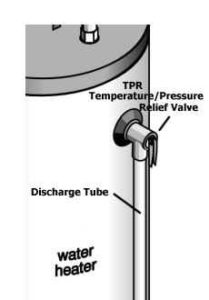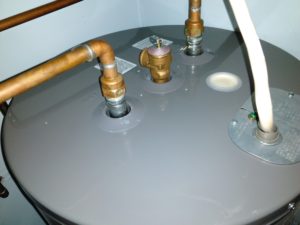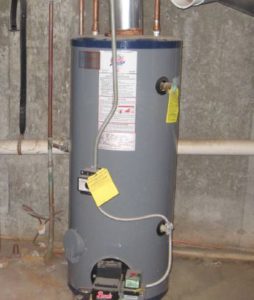I recently read a story of a water heating unit that did not have a TPR valve properly installed on it, effectively turning it into a ballistic missile when it malfunctioned:
A Water Heater Can Become an Explosive Missile:
“The steam-powered tank hurtled across the busy intersection at First Avenue South and South 152nd Street — over at least six lanes of traffic — before landing more than 439 feet away in the parking lot of a Pizza Hut. …[the] water heater landed 70 feet from a Kannapolis, North Carolina, home and did an estimated $20,000 worth of damage when it exploded. According to the report, the heater lacked a TPR valve altogether.”

What is a TPR Valve?
Most home owners do not know what a TPR valve is or looks like, let alone the importance of having one. In any event, these little valves should never be capped, sealed shut, or left without having an extension pipe added. In case you aren’t familiar, a TPR valve stands for Temperature Pressure Release Valve. This valve is designed to release water from a water heater if either the temperature is too high or if the pressure is too high. The point is, if pressure builds up in a water heater, the valve releases the pressure by letting water out, as opposed to creating an unpredictable and dangerous exploding missile.
What is a TPR Valve Extension Pipe?
Codes require that an extension tailpipe be added to a TPR valve so that if any pressure builds up and is forced out, then it will not spray accidentally into someone’s face, but will spray towards the floor. The TPR valves are installed either on the top of a unit or on the side of water heaters. The extension tailpipe, also called a discharge pipe, should terminate no more than six inches off of the floor, per building safety codes.
Photo of a TPR valve at top of an electric water heater (in the center):

Photo of a combustion water heater with side TPR valve:
 A missing TPR valve extension pipe is one of the more common mistakes found in a home inspection. Recently, when I found a water heater in a home that was recently installed, that did not have a TPR extension pipe, the owner outlined that the plumber had stated that TPR valve extension pipes are not required on electric water heaters. This did not seem correct for a number of reasons. First, if there is no need for any TPR tail pipe on an electric water heater, then this implies that there is no need for a TPR valve at all on such units. However, the Rheem electric water heater in question did have a TPR valve installed on its top (see the first photo, above). Only tank-less, on-demand water heaters come with no TPR valve, because there is no storage tank that can possibly build up pressure.
A missing TPR valve extension pipe is one of the more common mistakes found in a home inspection. Recently, when I found a water heater in a home that was recently installed, that did not have a TPR extension pipe, the owner outlined that the plumber had stated that TPR valve extension pipes are not required on electric water heaters. This did not seem correct for a number of reasons. First, if there is no need for any TPR tail pipe on an electric water heater, then this implies that there is no need for a TPR valve at all on such units. However, the Rheem electric water heater in question did have a TPR valve installed on its top (see the first photo, above). Only tank-less, on-demand water heaters come with no TPR valve, because there is no storage tank that can possibly build up pressure.
In order to get some more feedback on the electric Rheem unit, I called the manufacturer. The Rheem technical service assistant told me on the phone that I needed to call the local building code office to find out if it is required by code. However, when I asked for the official advice of Rheem, he said that TPR valve extension pipes are recommended on all of their water heaters, whether combustion or electric. When you consider that TPR valves release not just based on pressure, but also based on extreme temperature, then this makes all the more sense. When in doubt, it is better to be safe than sorry, especially with regard to such an inexpensive add on.
Tags: Do electric water heaters need a TPR pipe, what is a TPR valve? code for electric water heater TPR pipe, house safety, TPR discharge pipe,
